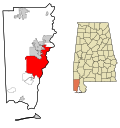Sodality Chapel | |
 The Sodality Chapel in 2008 | |
| Location | Mobile, Alabama |
|---|---|
| Coordinates | 30°41′32″N88°8′7″W / 30.69222°N 88.13528°W |
| Built | 1850 |
| Architectural style | Greek Revival |
| MPS | 19th Century Spring Hill Neighborhood Thematic Resource |
| NRHP reference No. | 84000122 [1] |
| Added to NRHP | October 18, 1984 |
The Sodality Chapel is a historic Roman Catholic chapel building on the campus of Spring Hill College in Mobile, Alabama, United States. It was built in 1850 in a simple Greek Revival style. [2] The building was placed on the National Register of Historic Places as a part of the 19th Century Spring Hill Neighborhood Thematic Resource on October 18, 1984. [1]






